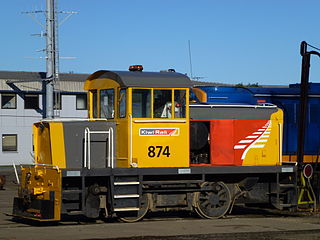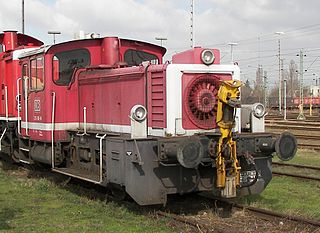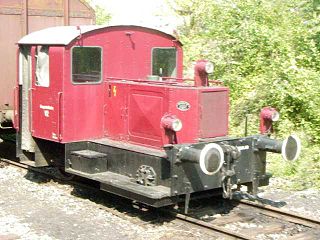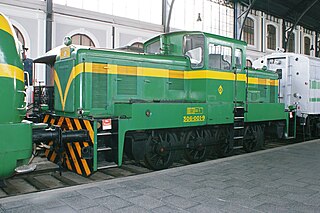
A diesel locomotive is a type of railway locomotive in which the power source is a diesel engine. Several types of diesel locomotives have been developed, differing mainly in the means by which mechanical power is conveyed to the driving wheels. The most common are diesel-electric locomotives and diesel-hydraulic.

The Northern Ireland Railways DH class was a class of three diesel-hydraulic shunting locomotives obtained in 1969. All three have now been withdrawn, and two have since been rebuilt for work in Sri Lanka.

A fluid coupling or hydraulic coupling is a hydrodynamic or 'hydrokinetic' device used to transmit rotating mechanical power. It has been used in automobile transmissions as an alternative to a mechanical clutch. It also has widespread application in marine and industrial machine drives, where variable speed operation and controlled start-up without shock loading of the power transmission system is essential.

The New Zealand TR class locomotive is a type of diesel shunting locomotives built by many different manufacturers. Defined as "shunting tractors" or "rail tractors" by KiwiRail and its predecessors, they are classified "TR" for tractor as a result. Many of these locomotives have been withdrawn, but some are still in service. The first locomotive of this class was built by NZR in 1924. The most powerful were Japanese-built Hitachi TRs, with 138 kW Cummins engines.
Turbo transmissions are hydrodynamic, multi-stage drive assemblies designed for rail vehicles using internal combustion engines. The first turbo-transmission was developed in 1932 by Voith in Heidenheim, Germany. Since then, improvements to turbo-transmissions have paralleled similar advances in diesel motors and today this combination plays a leading role worldwide, second only to the use of electrical drives.

German Kleinlokomotiven like the DRG Kö II were developed as locomotives with a low weight and driving power for light shunting duties. There were two classes, based on engine power. The Class II were engines which developed more than 40 HP.

The DB Class V 60 is a German diesel locomotive operated by the Deutsche Bundesbahn (DB) and later, the Deutsche Bahn AG, which is used particularly for shunting duties, but also for hauling light goods trains. Seventeen locomotives were bought used by the Norwegian State Railways and designated NSB Di 5. Also the Yugoslav Railways bought used units, and designated them JŽ 734; they were subsequently designated Series 2133 by the Croatian Railways.

The DB railways Köf III class are light two axle shunting locomotives of Deutsche Bahn AG.

Gmeinder GmbH was a German locomotive and engineering company based in Mosbach. Its products included diesel engines, small locomotives (shunters) and other railway locomotive parts. Much of its business came through the German railways, though it also exported to the rest of Europe and the rest of the world.

A Kleinlokomotive or Kleinlok is a German locomotive of small size and low power for light shunting duties at railway stations and on industrial railways. Most are powered by diesel engines, but Kleinloks with steam, petrol, or electric engines were also produced.

The Kleinlokomotiven of Class I were light German locomotives of low weight and power designed for shunting duties. They were placed in service by the Deutsche Reichsbahn (DRG) after trials had been carried out on several prototype locomotives in 1930. The power source for these locomotives was either a diesel or petrol engine.
Steam traction was the predominant form of motive power used by the Deutsche Reichsbahn on its narrow-gauge railways. For certain duties diesel locomotives were also used, albeit these were usually second-hand or rebuilt engines.

The China Railways DFH1 was a type of 4-axle B'B' single-cab diesel-hydraulic locomotive used on mainline passenger services; the DFH3 was a later development of a similar design but with two driving cabs.

The DR Class V 100, redesignated the Class 110 in 1970, was a four-axled diesel locomotive for medium duties operated by the Deutsche Reichsbahn of East Germany. Locomotives of the type were also supplied to railways in China and Czechoslovakia and to various industrial operators.

The NZR DSA class locomotive was a type of 0-6-0DM diesel-mechanical locomotives built by three different manufacturers: W. G. Bagnall, Hunslet, Mitsubishi Heavy Industries, and Vulcan Foundry for the Drewry Car Co. They were built between 1953 and 1967.

The Yorkshire Engine Company Taurus and Indus locomotives were two very similar lines of 0-8-0, diesel-hydraulic locomotives that weighed 58 tons and had a maximum speed of 36 mph (58 km/h). The two Rolls-Royce C8SFL diesel engines gave a total of 600 hp (450 kW). The transmission of the Taurus locomotives worked on a similar principle to that of the Fell diesel tested during the early 1950s. In this case, at low speeds only one engine was used, the second being engaged between 3.5 mph and 15 mph to enable haulage of 300 - 500 ton loads at speeds of up to 36 mph. The maximum speed with one engine was 12 mph (19 km/h) while the minimum speed with both engines was 3.5 mph (5.6 km/h). Both engines drove to a common torque converter and used a common throttle control with a separate lever being provided to engage the second engine as the need arose.
The Audi R8 LMS Cup was a one-make sports car racing series by Audi based in Asia. Audi R8 LMS Cup cars were based on the Audi R8 LMS (GT3).

ZT 300 is a series of 20 kN agricultural tractors, produced from 1 September 1967 to 1984 by the VEB Traktorenwerk Schönebeck. It succeeded the RS14 Famulus series, and unlike the Famulus, the ZT 300 series was sold under the brand name Fortschritt ("Progress"). ZT 300 refers both to the initial ZT 300 model, and the ZT 300 series. In total, 72,382 units of the ZT 300 series were made. The model with the highest production figure was the ZT 303, which was introduced in 1972. It features an automatic all-wheel-drive system; in the early 1980s, it cost 81,000 Mark. Starting in 1983, the ZT 300 series was succeeded by the ZT 320.

An internal combustion locomotive is a type of railway locomotive that produces its pulling power using an internal combustion engine. These locomotives are fuelled by burning fossil fuels, most commonly oil or gasoline, to produce rotational power which is transmitted to the locomotive's driving wheels by various direct or indirect transmission mechanisms. The fuel is carried on the locomotive.
CFR Series 040 DH are locomotives produced in large numbers, equipped with a hydrodynamic power transmission. They were used for shunting and light mainline service by the Romanian state railways CFR. In addition, 475 locomotives of this type were delivered to Romanian industrial companies, 263 units were delivered to Bulgaria, 42 units were delivered to industrial companies in Czechoslovakia, three units went to Iraq, two units went to China and one unit was delivered to the USSR.


















